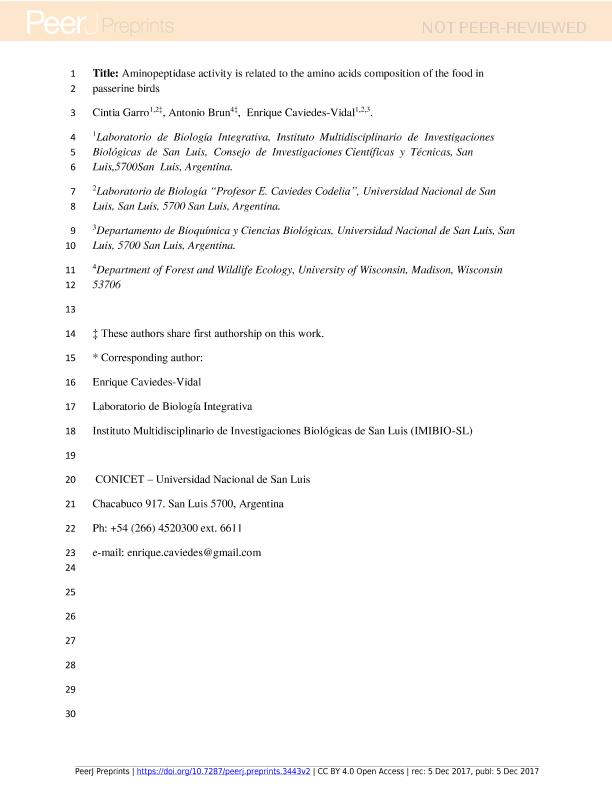Artículo
Aminopeptidase activity is related to the amino acids composition of the food in passerine birds
Fecha de publicación:
12/2017
Editorial:
PeerJ
Revista:
PeerJ Preprints
ISSN:
2167-9843
Idioma:
Inglés
Tipo de recurso:
Artículo publicado
Clasificación temática:
Resumen
Background. Passerine birds exploit different kinds of feeding habits and they have to face seasonal changes in food availability. Therefore, the composition of the principal nutrient in their food differs from the usual. In consequence the digestive function ? enzyme hydrolysis and absorption ? have to adapt to these nutrients. These changes in digestive physiology could respond to the adaptive modulation hypothesis which postulated that the activities of digestive enzymes should match the levels of their substrates in their diet so energy is not wasted on enzymes that are no need. Thus, we decide to measure intestinal enzymes activities of two species of passerine birds that differ in natural diet. Overall we hypothesized that species with different feeding habits present enzyme activity according to the mainly component of the diet (e.g., carbohydrates, proteins). Our prediction is that the individuals will present enzyme activity proportionally to the primary components of the diets. Methods. We select for study: red ovenbirds (Furnarius rufus), which are strict insectivores and zebra finches (Taeniopygia guttata), which are specialist granivores. We complete the analysis with publish data for house sparrows (Passser domesticus) feed on high starch from the literature. To examine intestinal enzyme activities, we measured the activity of two disaccharidases (sucrase-isomaltase and maltase-glucoamilase) and one dipeptidase (aminopeptidase-N).Results. The average intestinal activity of sucrase shows that the omnivorous P. domesticus presents almost 4 times more activity than the granivorous T. guttata and more than 11 times than the insectivorous F. rufus. This difference is also reflected in the total sucrase hydrolytic capacity where P. domesticus has roughly 10 times more than the other two birds. Surprisingly in F. rufus we found maltase and aminopeptidase activity while sucrase activity was close to zero. In the case of the average activity of maltase for the omnivorous P. domesticus is approximately 40 % more than the granivorous T. guttata and more than 5 times than the insectivorous F. rufus. Although the total maltase hydrolytic capacity of P. domesticus is 5 times more than T. guttata and F. rufus. The average of aminopeptidase-N activity for F. rufus and T. guttata almost doubled the P. domesticus ones. Also F. rufus roughly doubles the other two birds in total aminopeptidase hydrolytic capacity.Discussion. This study has shown that exist a relationship between the levels of amino acids in the diet and the total aminopeptidase capacity, but in the case of carbohydrates this relationship is not evident.
Palabras clave:
Aminopeptidase
,
Passerine
,
Birds
,
Amino Acids
Archivos asociados
Licencia
Identificadores
Colecciones
Articulos(IMIBIO-SL)
Articulos de INST. MULTIDICIPLINARIO DE INV. BIO. DE SAN LUIS
Articulos de INST. MULTIDICIPLINARIO DE INV. BIO. DE SAN LUIS
Citación
Garro, Cintia Araceli; Brun, Antonio; Caviedes Vidal, Enrique Juan Raul; Aminopeptidase activity is related to the amino acids composition of the food in passerine birds; PeerJ; PeerJ Preprints; 5; 12-2017; 1-18; e3443v2
Compartir
Altmétricas




